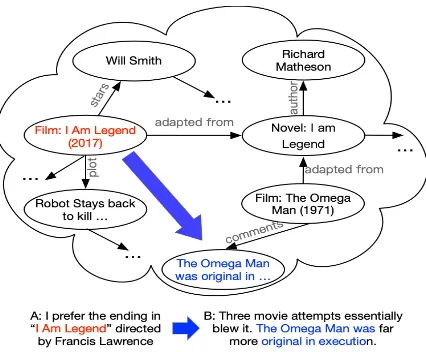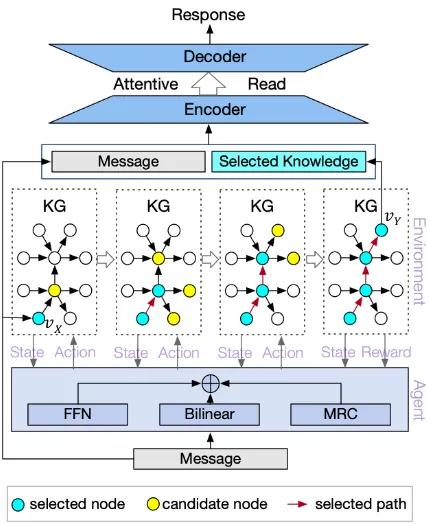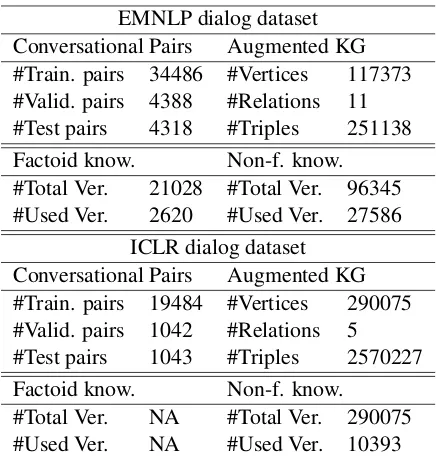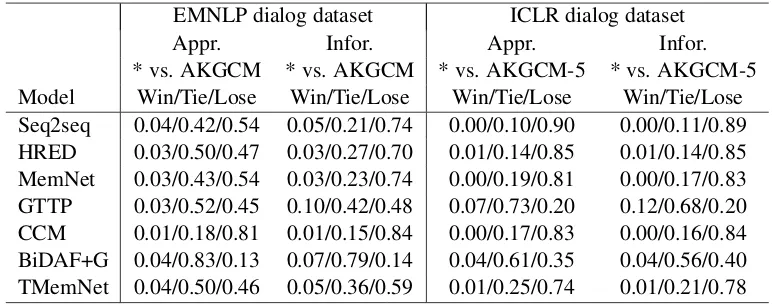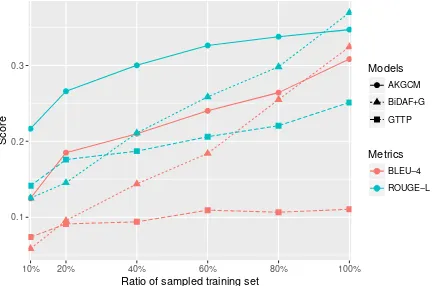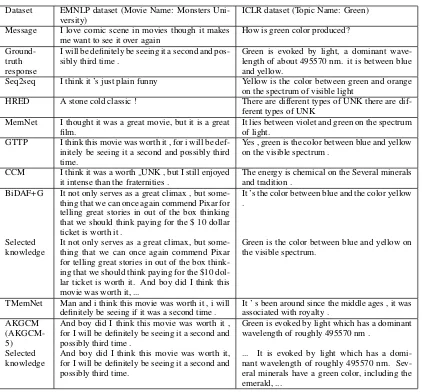Proceedings of the 2019 Conference on Empirical Methods in Natural Language Processing and the 9th International Joint Conference on Natural Language Processing, pages 1782–1792,
1782
Knowledge Aware Conversation Generation with Explainable Reasoning
over Augmented Graphs
Zhibin Liu, Zheng-Yu Niu, Hua Wu, Haifeng Wang Baidu Inc., Beijing, China
{liuzhibin05,niuzhengyu,wu hua, wanghaifeng}@baidu.com
Abstract
Two types of knowledge, triples from knowl-edge graphs and texts from documents, have been studied for knowledge aware open-domain conversation generation, in which graph paths can narrow down vertex candi-dates for knowledge selection decision, and texts can provide rich information for response generation. Fusion of a knowledge graph and texts might yield mutually reinforcing advan-tages, but there is less study on that. To address this challenge, we propose a knowl-edge aware chatting machine with three com-ponents, anaugmented knowledge graphwith both triples and texts, knowledge selector, and knowledge aware response generator. For knowledge selection on the graph, we formu-late it as a problem ofmulti-hop graph reason-ing to effectively capture conversation flow, which is more explainable and flexible in com-parison with previous work. To fully leverage long text information that differentiates our graph from others, we improve a state of the art reasoning algorithm withmachine reading comprehension technology. We demonstrate the effectiveness of our system on two datasets in comparison with state-of-the-art models1.
1 Introduction
One of the key goals of AI is to build a machine that can talk with humans when given an initial topic. To achieve this goal, the machine should be able to understand language with background knowledge, recall knowledge from memory or ex-ternal resource, reason about these concepts to-gether, and finally output appropriate and informa-tive responses. Lots of research efforts have been devoted to chitchat oriented conversation genera-tion (Ritter et al.,2011;Shang et al.,2015).
1Data and codes are available athttps://github.
com/PaddlePaddle/models/tree/develop/ PaddleNLP/Research/EMNLP2019-AKGCM
However, these models tend to produce generic responses or incoherent responses for a given topic, since it is quite challenging to learn seman-tic interactions merely from dialogue data without help of background knowledge. Recently, some previous studies have been conducted to introduce external knowledge, either unstructured knowl-edge texts (Ghazvininejad et al.,2018; Vougiouk-lis et al., 2016) or structured knowledge triples (Liu et al.,2018;Young et al.,2018;Zhou et al., 2018) to help open-domain conversation genera-tion by producing responses condigenera-tioned on se-lected knowledge.
In the first research line, their knowledge graph can help narrowing down knowledge candidates for conversation generation with the use of prior information, e.g., triple attributes or graph paths. Moreover, these prior information can enhance generalization capability of knowledge selection models. But it suffers from information insuffi-ciency for response generation since there is sim-ply a single word or entity to facilitate genera-tion. In the second line, their knowledge texts, e.g., comments about movies, can provide rich in-formation for generation, but its unstructured rep-resentation scheme demands strong capability for models to perform knowledge selection or atten-tion from the list of knowledge texts. Fusion of graph structure and knowledge texts might yield mutually reinforcing advantages for knowledge selection in dialogue systems, but there is less study on that.
Figure 1: Sample conversation with explainable reasoning, reflecting conversation flow, on an augmented knowledge graph.
in e.g., information oriented chatting scenarios, where a user needs to know how new knowledge in chatbot’s responses is linked to the knowledge in their utterances, or business scenarios, where a user cannot make a business decision without jus-tification.
To integrate texts into a knowledge graph, we take a factoid knowledge graph (KG) as its back-bone, and align unstructured sentences of non-factoid knowledge with the non-factoid KG by linking entities from these sentences to vertices (contain-ing entities) of the KG. Thus we augment the fac-toid KG with non-facfac-toid knowledge, and retain its graph structure. Then we use this augmented KG to facilitate knowledge selection and response generation, as shown in Figure1.
For knowledge selection on the graph, we adopt a deep reinforcement learning (RL) based reason-ing model(Das et al.,2018), MINERVA, in which the reasoning procedure greatly reflects conver-sation flow as shown in Figure 1. It is as ro-bust as embedding based neural methods, and is as explainable as path based symbolic methods. Moreover, our graph differs from previous KGs in that: some vertices in ours contain long texts, not a single entity or word. To fully leverage this long text information, we improve the reasoning algorithm with machine reading comprehension (MRC) technology (Seo et al., 2017) to conduct fine-grained semantic matching between an input message and candidate vertices.
Finally, for response generation, we use an encoder-decoder model to produce responses con-ditioned on selected knowledge.
In summary, we make following contributions:
• This work is the first attempt that unifies knowledge triples and texts as a graph, and conducts flexible multi-hop knowledge graph reasoning in dialogue systems. Supported by such knowledge and knowledge selection method, our system can respond more appro-priately and informatively.
• Our two-stage architecture and graph based knowledge selection mechanism provide bet-ter model explainability, which is very impor-tant for some application scenarios.
• For knowledge selection, to fully leverage long texts in vertices, we integrate machine reading comprehension (MRC) technology into the graph reasoning process.
2 Related Work
Conversation with Knowledge Graph: There are growing interests in leveraging factoid knowl-edge (Han et al.,2015;Liu et al.,2018;Zhu et al., 2017) or commonsense knowledge (Young et al., 2018; Zhou et al., 2018) with graph based rep-resentation for generation of appropriate and in-formative responses. Compared with them, we augment previous KGs with knowledge texts and integrate more explainable and flexible multi-hop graph reasoning models into conversation sys-tems. Wu et al. (2018) used document reasoning network for modeling of conversational contexts, but not for knowledge selection.
Conversation with Unstructured Texts: With availability of a large amount of knowledge texts from Wikipedia or user generated content, some work focus on either modeling of conversation generation with unstructured texts (Ghazvinine-jad et al., 2018; Vougiouklis et al., 2016; Xu et al., 2017), or building benchmark dialogue data grounded on knowledge (Dinan et al.,2019; Moghe et al.,2018). In comparison with them, we adopt a graph based representation scheme for un-structured texts, which enables better explainabil-ity and generalization capabilexplainabil-ity of our system.
technology (Das et al., 2018; Lin et al., 2018; Xiong et al., 2017), which can predict missing links for completion of KG. In this work, for knowledge selection on a graph, we follow the third line of works. Furthermore, our problem set-ting is different from theirs in that some of our ver-tices contain long texts, which motivates the use of machine reading technology for graph reasoning.
Fusion of KG triples and texts: In the task of QA, combination of a KG and a text corpus has been studied with a strategy of late fusion (Gard-ner and Krishnamurthy,2017;Ryu et al.,2014) or early fusion (Das et al.,2017b;Sun et al.,2018), which can help address the issue of low coverage to answers in KG based models. In this work, we conduct this fusion for conversation generation, not QA, and our model can select sentences as an-swers, not restricted to entities in QA models.
3 The Proposed Model
3.1 Problem Definition and Model Overview
Our problem is formulated as follows: Let G =
{V,E,LE}be an augmented KG, whereV is a set of vertices,E is a set of edges, andLE is a set of
edge labels (e.g., triple attributes, or vertex cate-gories). Given a message X = {x1, x2, ..., xm}
and G, the goal is to generate a proper response
Y ={y1, y2, ..., yn}with supervised models.
Es-sentially, the system consists of two stages: (1) knowledge selection: we select the vertex that maximizes following probability as an answer, which is from vertex candidates connected tovX:
vY = arg max
v PKS(v|vX,G, X). (1)
vXis one of vertices retrieved fromGusing the
en-tity or words inX, and it is ranked as top-1 based on text similarity with X. Please see Equation8 and10 for computation ofPKS(∗); (2) response
generation: it estimates the probability:
PRG(Y|X, vY) = n Y
t=1
P(yt|y<t, X, vY). (2)
The overview of our Augmented Knowledge Graph based Chatting Machine (AKGCM) is shown in Figure 2. The knowledge selector first takes as input a message X = {x1, x2, ..., xm}
and retrieves a starting vertex vX fromG that is
closely related toX, and then performs multi-hop graph reasoning onG and finally arrives at a ver-texvY that has the knowledge being appropriate
𝑣"
[image:3.595.311.525.64.326.2]𝑣#
Figure 2:The architecture of AKGCM.
for response generation. The knowledge aware response generator produces a response Y =
{y1, y2, ..., yn}with knowledge fromvY. At each
decoding position, it attentively reads the selected knowledge text, and then generates a word in the vocabulary or copies a word in the knowledge text.
For model training, each pair of [message, re-sponse] in training data is associated with ground-truth knowledge and its vertex ID (ground-ground-truth vertex) inGfor knowledge grounding. These ver-tex IDs will be used as ground-truth for training of knowledge selector, while the triples of [mes-sage, knowledge text, response] will be used for the training of knowledge aware generator.
3.2 Augmented Knowledge Graph
3.3 Knowledge Selection on the Graph
Task Definition: We formulate knowledge selec-tion on G as a finite horizon sequential decision making problem. It supports more flexible multi-hop walking on graphs, not restricted to one-multi-hop walking as done in previous work (Han et al., 2015;Zhou et al.,2018;Zhu et al.,2017).
As shown in Figure 2, we begin by represent-ing the environment as a deterministic partially observed Markov decision process (POMDP) on
G built in Section 3.2. Our RL based agent is given an input query of the form(vX, X).
Start-ing from vertexvX corresponding to X inG, the
agent follows a path in the graph, and stops at a vertex that it predicts as the answer vY. Using a
training set of known answer vertices for message-response pairs, we train the agent using policy gra-dients (Williams,1992) with control variates.
The difference between the setting of our prob-lem and previous KG reasoning lies in that: (1) the content of our input queries is not limited to enti-ties and attributes; (2) some vertices in our graph contains long texts, while vertices in previous KGs just contain a single entity or short text. It moti-vates us to make a few improvements on previous models, as shown in Equation (5), (6), and (7).
Next we elaborate the 5-tuple(S,O,A, δ,R)of the environment, and policy network.
States: A stateSt ∈ S at time steptis
repre-sented bySt= (vt, vX, X, vgt)and the state space
consists of all valid combinations inV ×V ×X ×V, wherevtis current location of the RL agent,vgtis
the ground-truth vertex, andX is the set of all pos-sibleX.
Observations: The complete state of the en-vironment cannot be observed. Intuitively, the agent knows its current location(vt)and(vX, X),
but not the ground-truth one (vgt), which
re-mains hidden. Formally, the observation
func-tion O : S−→V × V × X is defined as O(St =
(vt, vX, X, vgt)) = (vt, vX, X).
Actions:The set of possible actionsASt from a stateStconsists of all outgoing edges of the vertex
vtinG. FormallyASt ={(vt, le, vd) ∈ E :St =
(vt, vX, X, vgt), le∈ LE, vd∈ V} ∪ {(St,∅, St)}.
It means an agent at each state has option to se-lect which outgoing edge it wishes to take with the label of the edgeleand destination vertexvd.
We limit the length of the action sequence (hori-zon length) up to a fixed number (e.g.,T) of time steps. Moreover, we augment each vertex with a
special action called ‘NO OP’ which goes from a vertex to itself. This decision allows the agent to remain at a vertex for any number of time steps. It is especially helpful when the agent has managed to reach a correct vertex at a time stept < T and can continue to stay at the vertex for the rest of the time steps.
Transition: The environment evolves deter-ministically by just updating the state to the new vertex according to the edge selected by the agent. Formally, the transition function δ : S × A−→S
is defined by δ(St, A) = (vd, vX, X, vgt), where
St = (vt, vX, X, vgt) andA = (vt, le, vd). le is
the label of an edge connectingvtandvd, andvd
is destination vertex.
Rewards:AfterT time steps, if the current ver-tex is the ground-truth one, then the agent receives a reward of+1otherwise0. Formally,R(ST) =
I{vT =vgt}, whereST = (vT, vX, X, vgt)is the
final state.
Policy Network: We design a randomized non-stationary policyπ = (d0, d1, ..., dT−1), where dt = P(ASt) is a policy at time step t. In this
work, for each dt, we employ a policy network
with three components to make the decision of
choosing an action from all available actions (ASt)
conditioned onX.
The first component is a history dependent
feed-forward network(FFN) based model proposed in
(Das et al.,2018). We first employ a LSTM to en-code the historyHt= (Ht−1, At−1, Ot)as a
con-tinuous vectorht ∈R2d, whereHtis the sequence
of observations and actions taken. It is defined by:
ht=LST M(ht−1,[at−1;ot]), (3)
whereat−1 is the embedding of the relation
cor-responding to the label of the edge the agent chose at timet−1andotis the embedding of the vertex
corresponding to the agent’s state at timet. Recall that each possible action represents an outgoing edge with information of the edge re-lation label le and destination vertex vd. So let
[le;vd]denote an embedding for each actionA∈ ASt, and we obtain the matrixAtby stacking
em-beddings for all the outgoing edges. Then we build a two-layer feed-forward network with ReLU non-linearity which takes in the current history repre-sentationhtand the representation ofX (enewX ).
We use another single-layerfeed-forward network
updated FFN model for action decision is defined by:
PF F N(ASt) =At(W2ReLU
(W1[ht;ot;enewX ] +b1) +b2),
(4)
enewX =ReLU(WXeX +bX). (5)
Recall that in our graph, some vertices contain long texts, differentiating our graph from others in previous work. The original reasoning model (Das et al., 2018), MINERVA, cannot effectively exploit the long text information within vertices since it just learns embedding representation for the whole vertex, without detailed analysis of text in vertices. To fully leverage the long text informa-tion in vertices, we employ two models,a machine
reading comprehension model(MRC) (Seo et al.,
2017) anda bilinear model, to score each possible
vdfrom both global and local view.
For scoring from global view, (1) we build a document by collecting sentences from all possi-blevd, (2) we employ the MRC model to predict
an answer span (spanaw) from the document, (3)
we score eachvdby calculating a ROUGE-L score
vector ofvd’s sentence withspanaw as the
refer-ence, shown as follows:
PM RC(ASt) =ROU GE(T ext(Vd), spanaw).
(6) Here,T ext(·)represents operation of getting text contents, andROU GE(·)represents operation of calculating ROUGE-L score. We see that the MRC model can help to determine whichvdis the
best based on global information from the whole document.
For scoring from local view, we use another
bilinear model to calculate similarity between X
andvd, shown as follows:
PBi(ASt) =VdWBeX. (7)
Finally, we calculate a sum of outputs of the three above-mentioned models and outputs a prob-ability distribution over the possible actions from which a discrete action is sampled, defined by:
P(ASt) =sof tmax(αPF F N(ASt)+
βPBi(ASt) +γPM RC(ASt)),
(8)
At∼Sample(P(ASt)), (9)
PKS(vd|vX,G, X) =P(AST−1). (10)
Please see Section 3.1 for definition of PKS(∗).
When the agent finally arrives atST, we obtainvT
as the answervY for response generation.
Training: For the policy network (πθ)
de-scribed above, we want to find parametersθ that maximize the expected reward:
J(θ) =E(v0,X,vgt)∼DEA0,...,AT−1∼πθ
[R(ST)|S0 = (v0, v0, X, vgt)],
(11)
where we assume there is a true underlying distri-butionD, and(v0, X, vgt)∼D.
3.4 Knowledge Aware Generation
Following the work of Moghe et al. (2018), we modify a text summarization model (See et al., 2017) to suit this generation task.
In the summarization task, its input is a docu-ment and its output is a summary, but in our case the input is a [selected knowledge, message] pair and the output is a response. Therefore we intro-duce two RNNs: one is for computing the repre-sentation of the selected knowledge, and the other for the message. The decoder accepts the two rep-resentations and its own internal state representa-tion as input, and then compute (1) a probabil-ity score which indicates whether the next word should be generated or copied, (2) a probability distribution over the vocabulary if the next word needs to be generated, and (3) a probability distri-bution over the input words if the next word needs to be copied. These three probability distributions are then combined, resulting inP(yt|y<t, X, vY),
to produce the next word in the response.
4 Experiments and Results
4.1 Datasets
We adopt two knowledge grounded multi-turn dia-logue datasets for experiments, shown as follows: EMNLP dialog dataset (Moghe et al., 2018) This Reddit dataset contains movie chats from two participants, wherein each response is explic-itly generated by copying or modifying sentences from background knowledge such as IMDB’s facts/plots, or Reddit’s comments about movies. We follow their data split for training, validation and test2. Their statistics can be seen in Table1.
ICLR dialog dataset (Dinan et al.,2019)This wizard-of-wiki dataset contains multi-turn
conver-2We use the single-reference mixed-short test set for
EMNLP dialog dataset Conversational Pairs Augmented KG #Train. pairs 34486 #Vertices 117373 #Valid. pairs 4388 #Relations 11 #Test pairs 4318 #Triples 251138 Factoid know. Non-f. know.
#Total Ver. 21028 #Total Ver. 96345 #Used Ver. 2620 #Used Ver. 27586
ICLR dialog dataset Conversational Pairs Augmented KG #Train. pairs 19484 #Vertices 290075 #Valid. pairs 1042 #Relations 5 #Test pairs 1043 #Triples 2570227 Factoid know. Non-f. know.
[image:6.595.72.290.60.288.2]#Total Ver. NA #Total Ver. 290075 #Used Ver. NA #Used Ver. 10393
Table 1: The upper/lower two tables show statistics of the EMNLP/ICLR datasets and corresponding aug-mented knowledg graphs. #Used Ver. means total num of vertices that used for response generation. For more details, please visit our data sharing URL.
sations from two participants. One participant se-lects a beginning topic, and during the conversa-tion the topic is allowed to naturally change. The two participants are not symmetric: one will play the role of a knowledgeable expert while the other is a curious learner. We filter their training data and test data by removing instances without the use of knowledge and finally keep 30% instances3 for our study since we focus on knowledge selec-tion and knowledge aware generaselec-tion. Their statis-tics can be seen in Table1. For models (Seq2Seq, HRED) without the use of knowledge, we keep the original training data for them.
4.2 Experiment Settings
We follow the existing work to conduct both au-tomatic evaluation and human evaluation for our system. We also compare our system with a set of carefully selected baselines, shown as follows.
Seq2Seq: We implement a sequence-to-sequence model (Seq2Seq) (Sutskever et al., 2014), which is widely used in open-domain con-versational systems.
HRED:We implement a hierarchical recurrent encoder-decoder model (Serban et al.,2016).
MemNet: We implement an end-to-end
3Their ground-truth responses should have high
ROUGE-L scores with corresponding ground-truth knowledge texts.
knowledge-MemNet based conversation model (Ghazvininejad et al.,2018).
GTTP: It is an end-to-end text summarization model (See et al., 2017) studied on the EMNLP data. We use the code4 released by Moghe et al. (2018), where they modify GTTP to suit knowl-edge aware conversation generation.
BiDAF+G:It is a Bi-directional Attention Flow based QA Model (BiDAF) (Seo et al.,2017) that performs best on the EMNLP dataset. We use the code4released byMoghe et al.(2018), where they use it to find the answer span from a knowledge document, taking the input message as the query. Moreover, we use a response generator (as same as ours) for NLG with the predicted knowledge span. TMemNet: It is a two-stage transformer-MemNet based conversation system that performs best on the ICLR dataset (Dinan et al.,2019). We use the code5released by the original authors.
CCM:It is a state-of-the-art knowledge graph based conversation model (Zhou et al.,2018). We use the code6 released by the original authors and then modify our graph to suit their setting by se-lecting each content word from long text as an in-dividual vertex to replace our long-text vertices.
AKGCM:It is our two-stage system presented in Section 3. We implement our knowledge se-lection model based on the code7 by(Das et al., 2018) and that4 by (Moghe et al., 2018). We use BiDAF as the MRC module, shown in Equation (6), and we train the MRC module on the same training set for our knowledge selection model. We implement the knowledge aware generation model based on the code of GTTP4 released by (Moghe et al.,2018). We also implement a vari-ant AKGCM-5, in which top five knowledge texts are used for generation, and other setting are not changed.
4.3 Automatic Evaluations
Metrics: Following the work of (Moghe et al., 2018), we adopt BLEU-4 (Papineni et al.,2002), ROUGE-2 (Lin, 2004) and ROUGE-L (Lin and Och,2004) to evaluate how similar the output re-sponse is to the reference text. We use Hit@1 (the top 1 accuracy) to evaluate the performance of knowledge selection.
4https://github.com/nikitacs16/Holl-E 5
https://parl.ai/projects/wizard_of_ wikipedia/
6
https://github.com/tuxchow/ccm
EMNLP dialog dataset ICLR dialog dataset
BLEU-4 ROUGE-2 ROUGE-L Hit@1 BLEU-4 ROUGE-2 ROUGE-L Hit@1
Model (%) (%) (%) (%) (%) (%) (%) (%)
Seq2seq 1.59 5.73 14.49 NA 0.17 1.01 7.02 NA
HRED 2.08 8.83 18.13 NA 0.23 1.08 7.32 NA
MemNet 5.86 10.64 18.48 NA 0.89 2.33 11.84 NA
GTTP 11.05 17.70 25.13 NA 6.74 7.18 17.11 NA
CCM 2.40 4.84 17.70 NA 0.86 1.68 12.74 NA
BiDAF+G 32.45 31.28 36.95 40.80 6.48 6.54 15.56 17.40
TMemNet 8.92 13.15 19.97 38.10 1.09 1.86 8.51 16.80
AKGCM-5 13.29 13.12 21.22 42.04 6.94 7.38 17.02 18.24
[image:7.595.87.509.61.227.2]AKGCM 30.84 29.29 34.72 42.04 5.52 6.10 15.46 18.24
Table 2: Results of automatic evaluations on the two datasets.
EMNLP dialog dataset ICLR dialog dataset
Appr. Infor. Appr. Infor.
* vs. AKGCM * vs. AKGCM * vs. AKGCM-5 * vs. AKGCM-5 Model Win/Tie/Lose Win/Tie/Lose Win/Tie/Lose Win/Tie/Lose Seq2seq 0.04/0.42/0.54 0.05/0.21/0.74 0.00/0.10/0.90 0.00/0.11/0.89 HRED 0.03/0.50/0.47 0.03/0.27/0.70 0.01/0.14/0.85 0.01/0.14/0.85 MemNet 0.03/0.43/0.54 0.03/0.23/0.74 0.00/0.19/0.81 0.00/0.17/0.83 GTTP 0.03/0.52/0.45 0.10/0.42/0.48 0.07/0.73/0.20 0.12/0.68/0.20 CCM 0.01/0.18/0.81 0.01/0.15/0.84 0.00/0.17/0.83 0.00/0.16/0.84 BiDAF+G 0.04/0.83/0.13 0.07/0.79/0.14 0.04/0.61/0.35 0.04/0.56/0.40 TMemNet 0.04/0.50/0.46 0.05/0.36/0.59 0.01/0.25/0.74 0.01/0.21/0.78
Table 3: Results of human evaluations on the two datasets. AKGCM (or AKGCM-5) outperforms all the baselines significantly (sign test, p-value<0.05) in terms of the two metrics.
Results: As shown in Table 2, AKGCM (or AKGCM-5) can obtain the highest score on test set in terms of Hit@1, and the second highest scores in terms of BLEU-4, ROUGE-2 and ROUGE-L, surpassing other models, ex-cept BiDAF, by a large margin. It indicates that AKGCM has a capability of knowledge selection better than BiDAF and TMemNet, and generates more informative and grammatical responses. We notice that from EMNLP dataset to ICLR dataset, there is a significant performance drop for almost all the models. It is probably due to that the qual-ity of ICLR dataset is worse than that of EMNLP dataset. A common phenomenon of ICLR dataset is that the knowledge used in responses is loosely relevant to input messages, which increases the difficulty of model learning.
4.4 Human Evaluations
Metrics: We resort to a web crowdsourcing ser-vice for human evaluations. We randomly sample 200 messages from test set and run each model to
generate responses, and then we conduct pair-wise comparison between the response by AKGCM and the one by a baseline for the same message. In total, we have 1400 pairs on each dataset since there are seven baselines. For each pair, we ask five evaluators to give a preference between the two responses, in terms of the following two met-rics: (1) appropriateness (Appr.), e.g., whether the response is appropriate in relevance, and logic, (2) informativeness (Infor.), whether the response provides new information and knowledge in addi-tion to the input message, instead of generic re-sponses such as “This movie is amazing”. Tie is allowed. Notice that system identifiers are masked during evaluation.
[image:7.595.105.491.259.412.2]least 3/3 agreement is 55.5%.
Results: In Table3, each score for win/tie/lose is the percentage of messages for which AKGCM (or AKGCM-5) can generate better/almost same/worse responses, in comparison with a baseline. We see that our model outperforms all the baselines significantly (sign test, p-value
< 0.05) in terms of the two metrics on the two datasets. Furthermore, our model can beat the strongest baseline, BiDAF. It demonstrates the effectiveness of our graph reasoning mechanism that can use global graph structure information and exploit long text information. Our data analysis shows that both Seq2Seq and HRED tend to generate safe responses starting with “my favorite character is” or “I think it is”. Both Memnet and TMemnet can generate informative responses. But the knowledge in their responses tends to be incorrect, which is a serious problem for knowledge aware conversation generation. Our results show that GTTP and BiDAF are very strong baselines. It indicates that the at-tention mechanism (from machine reading) for knowledge selection and the copy mechanism can bring benefits for knowledge aware conversation generation. Although CCM have the mechanisms mentioned above, this model is good at dealing with structured triples rather than long texts. It may explain the inferior performance of CCM in our problem setting.
We find that many responses are likely to be a simple copy of the selected knowledge, which is a reflection of the characteristics of the datasets. In the two datasets, some sentences in the back-ground knowledge are directly used as responses to the messages. Therefore, the NLG module is likely to copy content from the selected knowledge as much as possible for generation. Moreover, the summarization model GTTP tends to copy words from its input message as its output due to its gen-eration mechanism. Table5presents the examples in which AKGCM (AKGCM-5) performs better than other models on two dataset.
4.5 Model Analysis
AKGCM without (w/o) Non-factoid Knowl-edge: To verify contribution of non-factoid knowledge, we remove non-factoid knowledge from augmented KG in test procedure, and re-port the performance of our system with only fac-toid knowledge in Table 4. We see that
with-BLEU-4 ROUGE-2 ROUGE-L
Model variant (%) (%) (%)
w/o non-factoid knowledge
0.61 0.84 1.52
w/o Bilinear + MRC
15.12 14.15 21.09
w/o MRC 18.41 17.79 24.59
w/o Bilinear 28.62 28.19 32.84
[image:8.595.311.529.251.394.2]Full model 30.84 29.29 34.72
Table 4: Results of ablation study for AKGCM on EMNLP dataset. We also include results of the full model for comparison.
0.1 0.2 0.3
10% 20% 40% 60% 80% 100%
Ratio of sampled training set
Score
Models
AKGCM BiDAF+G GTTP
Metrics
BLEU−4 ROUGE−L
Figure 3: Results of how each model performs on EMNLP dataset when we gradually reduce the ratio of sampled train-ing data from 100% to 10% (from right to left).
out non-factoid knowledge from EMNLP dataset, the performance of our system drops significantly in terms of BLEU and ROUGE. It indicates that non-factoid knowledge is essential for knowledge aware conversation generation.
AKGCM w/o the MRC Model or Bilinear One:For ablation study, we implement a few vari-ants of our system without the bilinear model or MRC for knowledge selection. Results of these variants are reported in Table4. If we compare the performance of our full model with its variants, we find that both MRC and the bilinear model can bring performance improvement to our sys-tem. It indicates that the full interaction between messages and knowledge texts by their attention mechanism is effective to knowledge selection.
Dataset EMNLP dataset (Movie Name: Monsters Uni-versity)
ICLR dataset (Topic Name: Green)
Message I love comic scene in movies though it makes me want to see it over again
How is green color produced?
Ground-truth response
I will be definitely be seeing it a second and pos-sibly third time .
Green is evoked by light, a dominant wave-length of about 495570 nm. it is between blue and yellow.
Seq2seq I think it ’s just plain funny Yellow is the color between green and orange on the spectrum of visible light
HRED A stone cold classic ! There are different types of UNK there are dif-ferent types of UNK
MemNet I thought it was a great movie, but it is a great film.
It lies between violet and green on the spectrum of light.
GTTP I think this movie was worth it , for i will be def-initely be seeing it a second and possibly third time.
Yes , green is the color between blue and yellow on the visible spectrum .
CCM I think it was a worth UNK , but I still enjoyed it intense than the fraternities .
The energy is chemical on the Several minerals and tradition .
BiDAF+G It not only serves as a great climax , but some-thing that we can once again commend Pixar for telling great stories in out of the box thinking that we should think paying for the $ 10 dollar ticket is worth it .
It ’s the color between blue and the color yellow .
Selected knowledge
It not only serves as a great climax, but some-thing that we can once again commend Pixar for telling great stories in out of the box think-ing that we should think paythink-ing for the $10 dol-lar ticket is worth it. And boy did I think this movie was worth it, ...
Green is the color between blue and yellow on the visible spectrum.
TMemNet Man and i think this movie was worth it , i will definitely be seeing if it was a second time .
It ’ s been around since the middle ages , it was associated with royalty .
AKGCM (AKGCM-5)
And boy did I think this movie was worth it , for I will be definitely be seeing it a second and possibly third time .
Green is evoked by light which has a dominant wavelength of roughly 495570 nm .
Selected knowledge
And boy did I think this movie was worth it, for I will be definitely be seeing it a second and possibly third time.
[image:9.595.90.512.57.449.2]... It is evoked by light which has a domi-nant wavelength of roughly 495570 nm. Sev-eral minSev-erals have a green color, including the emerald, ...
Table 5: Examples in which AKGCM performs better than other models on two dataset.
the strongest baseline, BIDAF+G, drops more dra-matically in comparison with AKGCM. It indi-cates that our graph reasoning mechanism can ef-fectively use the graph structure information for knowledge selection, resulting in better general-ization capability of AKGCM.
Model Explainability: We check the graph paths traversed by our system for knowledge se-lection and try to interpret what heuristics have been learned. We find that our system can learn to visit different types of vertices conditioned on conversational contexts, e.g.. selecting comment vertices as responses for utterances starting with “what do you think”. These results suggest that AKGCM may also be a good assistive tool for dis-covering new algorithms, especially in cases when the graph reasoning are new and less well-studied for conversation modeling.
5 Conclusion
In this paper, we propose to augment a knowl-edge graph with texts and integrate it into an open-domain chatting machine with both graph rea-soning based knowledge selector and knowledge aware response generator. Experiments demon-strate the effectiveness of our system on two datasets compared to state-of-the-art approaches.
Acknowledgments
References
Antoine Bordes, Nicolas Usunier, Alberto Garcia-Duran, Jason Weston, and Oksana Yakhnenko. 2013. Translating embeddings for modeling multirela-tional data. InProceedings of NIPS, pages 2787—-2795.
Rajarshi Das, Shehzaad Dhuliawala, Manzil Zaheer, Luke Vilnis, Ishan Durugkar, Akshay Krishna-murthy, Alex Smola, and Andrew McCallum. 2018. Go for a walk and arrive at the answer: reasoning over paths in knowledge bases using reinforcement learning. InProceedings of ICLR, pages 1–18.
Rajarshi Das, Arvind Neelakantan, David Belanger, and Andrew McCallum. 2017a. Chains of reasoning over entities, relations, and text using recurrent neu-ral networks. InProceedings of EACL, pages 132— -141.
Rajarshi Das, Manzil Zaheer, Siva Reddy, and Andrew McCallum. 2017b. Question answering on knowl-edge bases and text using universal schema and memory networks. In Proceedings of ACL, pages 358—-365.
Emily Dinan, Stephen Roller, Kurt Shuster, Angela Fan, Michael Auli, and Jason Weston. 2019. Wizard of wikipedia: knowledge-powered conversational agents. InProceedings of ICLR.
Matt Gardner and Jayant Krishnamurthy. 2017. Open-vocabulary semantic parsing with both distributional statistics and formal knowledge. InProceedings of AAAI, pages 3195—-3201.
Marjan Ghazvininejad, Chris Brockett, Ming-Wei Chang, Bill Dolan, Jianfeng Gao, Wen tau Yih, and Michel Galley. 2018. A knowledge-grounded neural conversation model. InProceedings of AAAI 2018, pages 5110–5117.
Sangdo Han, Jeesoo Bang, Seonghan Ryu, and Gary Geunbae Lee. 2015. Exploiting knowledge base to generate responses for natural language di-alog listening agents. InProceedings of SIGDIAL, pages 129—-133.
Ni Lao, Tom M. Mitchell, and William W. Cohen. 2011. Random walk inference and learning in a large scale knowledge base. In Proceedings of EMNLP, pages 529—-539.
Chin-Yew Lin. 2004. Rouge: a package for auto-matic evaluation of summaries. InProceedings of the Workshop on Text Summarization Branches Out (WAS 2004).
Chin-Yew Lin and Franz Josef Och. 2004. Auto-matic evaluation of machine translation quality us-ing longest common subsequence and skip-bigram statistics. InProceedings of ACL, pages 605–612.
Xi Victoria Lin, Richard Socher, and Caiming Xiong. 2018. Multi-hop knowledge graph reasoning with
reward shaping. In Proceedings of EMNLP, pages 3243—-3253.
Shuman Liu, Hongshen Chen, Zhaochun Ren, Yang Feng, Qun Liu, and Dawei Yin. 2018. Knowledge diffusion for neural dialogue generation. In Pro-ceedings of ACL, pages 1489—-1498.
Nikita Moghe, Siddhartha Arora, Suman Banerjee, and Mitesh M. Khapra. 2018. Towards exploiting back-ground knowledge for building conversation sys-tems. In Proceedings of EMNLP, pages 2322—-2332.
Kishore Papineni, Salim Roukos, Todd Ward, and Wei-Jing Zhu. 2002. Bleu: a method for automatic eval-uation of machine translation. In Proceedings of ACL, pages 311–318.
Alan Ritter, Colin Cherry, and William B. Dolan. 2011. Data-driven response generation in social media. In
Proceedings of EMNLP, pages 583—-593.
Pum-Mo Ryu, Myung-Gil Jang, and Hyun-Ki Kim. 2014. Open domain question answering using wikipedia-based knowledge model. InInformation Processing and Management, pages 50(5):683–692.
Abigail See, Peter J. Liu, and Christopher D. Manning. 2017. Get to the point: summarization with pointer-generator networks. InProceedings of ACL, pages 1073—-1083.
Min Joon Seo, Aniruddha Kembhavi, Ali Farhadi, and Hannaneh Hajishirzi. 2017. Bidirectional attention flow for machine comprehension. InProceedings of ICLR.
Iulian Vlad Serban, Alessandro Sordoni, Yoshua Ben-gio, Aaron C. Courville, and Joelle Pineau. 2016. Building end-to-end dialogue systems using gener-ative hierarchical neural network models. In Pro-ceedings of AAAI, pages 3776—-3784.
Lifeng Shang, Zheng dong Lu, and Hang Li. 2015. Neural responding machine for short-text conversa-tion. InProceedings of ACL, pages 1577—-1586.
Haitian Sun, Bhuwan Dhingra, Manzil Zaheer, Kathryn Mazaitis, Ruslan Salakhutdinov, and William W. Cohen. 2018. Open domain question answering us-ing early fusion of knowledge bases and text. In
Proceedings of EMNLP, pages 4231—-4242.
Ilya Sutskever, Oriol Vinyals, and Quoc V Le. 2014. Sequence to sequence learning with neural net-works. InProceedings of NIPS, pages 3104—-3112.
Pavlos Vougiouklis, Jonathon Hare, and Elena Simperl. 2016. A neural network approach for knowledge-driven response generation. InProceedings of COL-ING 2016, pages 3370—-3380.
Ronald J Williams. 1992. Simple statistical gradient-following algorithms for connectionist reinforce-ment learning. In Machine learning, pages 8(3– 4):229—-256.
Xianchao Wu, Ander Martınez, and Momo Klyen. 2018. Dialog generation using multi-turn reasoning neural networks. In Proceedings of NAACL-HLT, pages 2049—-2059.
Wenhan Xiong, Thien Hoang, and William Yang Wang. 2017. Deeppath: a reinforcement learning method for knowledge graph reasoning. In Proceed-ings of EMNLP, pages 564–573.
Zhen Xu, Bingquan Liu, Baoxun Wang, Chengjie Sun, and Xiaolong Wang. 2017. Incorporating loose-structured knowledge into lstm with recall gate for conversation modeling. In Proceedings of IJCNN, pages 3506–3513.
Tom Young, Erik Cambria, Iti Chaturvedi, Hao Zhou, Subham Biswas, and Minlie Huang. 2018. Aug-menting end-to-end dialogue systems with common-sense knowledge. In Proceedings of AAAI 2018, pages 4970–4977.
Hao Zhou, Tom Young, Minlie Huang, Haizhou Zhao, Jingfang Xu, and Xiaoyan Zhu. 2018. Com-monsense knowledge aware conversation generation with graph attention. In Proceedings of IJCAI-ECAI, pages 4623–4629.
